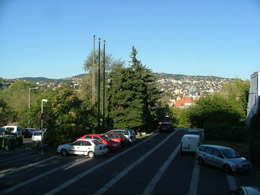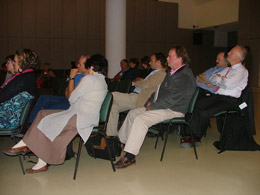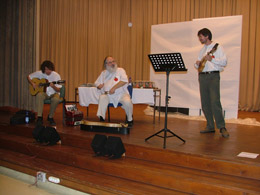The conference ended only a few hours ago as I’m starting to write this so it might be too early to draw any serious conclusions but I’ll be back with a more detailed report in the next couple of days – till then, let me share my overall impressions.

I think this was my eighth IATEFL Hungary conference, so I have grounds for comparison. I was there at this conference from opening till close, attended every plenary and went to a talk or workshop in each session. Overall, I think this was the best IATEFL Hungary conference I’ve ever attended – and this is saying a lot, considering the fact that I was involved with the organization of four previous conferences. What made it the best?
Venue: the Balassi Institute in Budapest proved to be a wise choice. Nice location, excellent rooms, all well-equipped.
Programme: this is easily the most important component of every conference. Either I was very lucky (or wise? :)) with my choices or the programme was really this good (clearly, it’s the latter). From time to time, you run into plenaries that you only go to because there’s no choice – not this time. All were interesting and informative, to say the least – more in detail about them in a later post.

The concurrent sessions were arranged into six slots, eight in each, five in the last; there were also five split sessions with two half-hour sessions in them, bringing the total to 49, unless my calculations are wrong. I find this a decent choice; although I know that we have had conferences with 10 or even 11 concurrent sessions, but that might be too many to choose from. I also know that there have been conferences with more than six concurrent session slots but it’s better to put convenient breaks between sessions than having to run from one workshop to another. I don’t know if this relative scarcity of presentations was due to the volume of submitted abstracts or it happened because the readers were strict but in the end it worked out very well – it’s better to have fewer but higher quality presentations. I think the right balance was found; I only heard very positive feedback from fellow participants. All the workshops and talks I attended were excellent and useful – even the one I very strongly disagreed with (again, more about this and the other talks in a later post).
The SIG afternoon: Definitely one of the highlights of the conference (I’ll be saying this for too many things, I’m afraid). The concept of SIG afternoons was first introduced at the Esztergom conference three years ago and it has worked very well since then. Not surprisingly, I’ve always attended the ICT SIG event, and this year was no exception. What made this year different was that for the first time we were not only in our old circle of converts but had a decent amount of new people. 32 colleagues took part, which was nice – other SIGs didn’t have a lot bigger audience either, which I think is one of the signs that ICT has finally come of age in Hungary too, but I’ll elaborate on the ICT issues of the conference in a later post.
Organization: I can only congratulate the organizers and thank the committee for their hard work; everything went smoothly. This is why I was disappointed to see a relatively low turnout, especially at the opening and close. I know that a Friday afternoon might not be the best time of the week for an English teacher, but to see Éva Illés start delivering her excellent opening plenary to an audience of 44 people was disheartening, even if people started trickling in during her talk. This presentation would have deserved a much larger audience and those who were not there should regret missing it. I didn’t know at that time that Gordon Lewis’ fantastic closing plenary will receive the same number of people. Every English teacher would have benefited enormously from these two presentations. I know that the slides will be published on the IATEFL Hungary website but it’s not the same thing. The committee did everything to get the word out, they put together an excellent programme at a very convenient and beautiful location, invited internationally renowned speakers, and then the largest crowd was around 140-150 for Herbert Puchta’s Saturday mid-day plenary (I didn’t count the audience at the plenary given by Tamás Kiss, again an excellent talk, should have been an eye-opener for most). This is not what these speakers deserved and not what the organizers deserved. I don’t know what else they could have done – perhaps we need to start begging each English teacher personally now to come? I know this sounds like when I was at university and our teachers started complaining about too few of us being present at their lecture – to us, who were actually there; but of course you can only talk to those who will listen… Also, let’s not forget that there were 25 nations represented at the conference (probably the highest number ever), which is excellent news – but not really if you realise that you have to deduct the number of international participants from the total to get the number of Hungarian teachers of English taking part…
The same goes for IATEFL Hungary membership, which now stands at around 420 (has been increasing recently). A decent size, considering the fact that it’s probably the highest ever, and even if it isn’t, I’m sure it’s never been above 500. But in a country of well over 50,000 English teachers, 22,000 of them working in public education, this is again disheartening. Especially if we consider the fact that this is the only professional association for teachers of English. The current committee has been working very hard for the past couple of years to increase membership, and they have managed to recruit quite a few new members – again, hats off to them, unconditionally. When I was on the committee, our priority was also to increase membership – and the same has been true for all committees for the past 20 years. And this is the result: between .5 and 1 per cent, depending on how you define your target audience. And don’t tell me it’s because of the price. Publishers’ free conferences rarely attract more than 300 people, usually fewer – and you mostly see the same faces there too. The interest is just not there, it seems. You can’t say that all the committees in the past 20 years have failed to come up with anything convincing – clearly it’s not their fault. I’ll go out on a limb and say that maybe it’s time to accept the fact that the vast majority of English teachers in Hungary is simply not interested in cooperation and building a community, so maybe we should rearrange our priorities and stop using the scarce resources to try and increase membership – there will be more left for catering to the needs of the existing members.
I just had to say these things because I was really sad to see the most important professional event of the year attract a relatively low number of Hungarian colleagues, especially when it was so great. Those of us who were there definitely enjoyed an excellent conference – the last component that made the whole experience so good is…

The social programme: I must confess that this is where I missed an event but from what I heard, Friday night’s musical entertainment was a huge success. But luckily I did go to Saturday’s Pecha Kucha night, organised by Lindsay Clandfield. This was the first such event in Hungary, and I’m sure there will be many more to follow. It is a stress test for the presenters, and enormous fun for the audience – I don’t remember the last time I laughed so much at a professional event; most probably at a talk given by Peter Medgyes – and this comparison should say a lot about the quality.
One more thing has to be mentioned in connection with the conference: in keeping with the tradition of publishing a “mELTing pot Extra” for each conference, this year’s thematic issue was on ICT. Now, if reading this magazine doesn’t convince an English teacher that it’s worth joining IATEFL Hungary, nothing will. I’ll write a separate post about it later – till then I can only say one thing: grab a copy if you haven’t done so yet. Mark Andrews and Anna Csíky did a great job – you’ll learn a lot from reading it.
It would be nice to read other participants’ comments; also, if you have also written a report on this conference, I’d like to link to it. And don’t forget that I’ll be back with a post on the talks I attended, another one on the ICT issues raised at the conference, plus a third one on mELTing pot Extra.
In closing, let me congratulate and thank the committee and the organisers again for all their hard work.